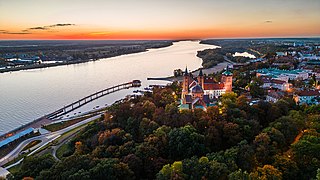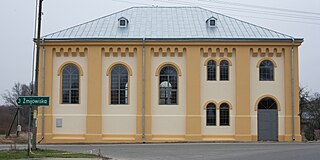
Płock is a city in central Poland, on the Vistula river, in the Masovian Voivodeship. According to the data provided by GUS on 31 December 2021, there were 116,962 inhabitants in the city. Its full ceremonial name, according to the preamble to the City Statute, is Stołeczne Książęce Miasto Płock. It is used in ceremonial documents as well as for preserving an old tradition.

Gąbin is a small town in Płock County, Masovian Voivodeship, Poland, with 4,065 inhabitants as of December 2021. The Warsaw radio mast, which stood near Gąbin, was the tallest structure in the world until its collapse in 1991. It remained the highest structure ever created till 2010.

Krasnosielc is a village in Maków County, in the Masovian Voivodeship, on the river Orzyc, in east-central Poland. It is the seat of the administrative district (gmina) called Gmina Krasnosielc. It lies approximately 18 kilometres (11 mi) north of Maków Mazowiecki and 90 km (56 mi) north of Warsaw.

Radziejów is a town in Poland, in Kuyavian-Pomeranian Voivodeship, about 45 km south of Toruń. It is the capital of Radziejów County. Its population is 5,696 (2010).

Płock County is a unit of territorial administration and local government (powiat) in Masovian Voivodeship, east-central Poland. It came into being on January 1, 1999, as a result of the Polish local government reforms passed in 1998. Its administrative seat is the city of Płock, although the city is not part of the county. The county contains three towns: Gąbin, 17 km (11 mi) south of Płock, Drobin, 29 km (18 mi) north-east of Płock, and Wyszogród, 39 km (24 mi) south-east of Płock.

Strzegowo is a village on the Wkra river in Mława County, Masovian Voivodeship, in east-central Poland. It is the seat of the gmina called Gmina Strzegowo. It was formerly known as Strzegowo-Osada. It lies approximately 25 kilometres (16 mi) south of Mława and 91 km (57 mi) north-west of Warsaw.
Vistula Germans are ethnic Germans who had settled in what became known after the 1863 Polish rebellion as the Vistula Territory. This territory, so designated by the ruling Russians of the time, encompassed most of the Vistula river basin of central Poland up to just east of Toruń.
Gmina Gąbin is an urban-rural gmina in Płock County, Masovian Voivodeship, in east-central Poland. Its seat is the town of Gąbin, which lies approximately 17 kilometres (11 mi) south of Płock and 89 km (55 mi) west of Warsaw.

Czemierniki is a town in Radzyń Podlaski County, Lublin Voivodeship, in eastern Poland. It is the seat of the gmina called Gmina Czemierniki. It lies approximately 13 kilometres (8 mi) south of Radzyń Podlaski and 48 km (30 mi) north of the regional capital Lublin.

Wielkie Oczy is a village in Lubaczów County, Subcarpathian Voivodeship, in south-eastern Poland, close to the border with Ukraine. It is the seat of the gmina called Gmina Wielkie Oczy. It lies approximately 17 kilometres (11 mi) south of Lubaczów and 83 km (52 mi) east of the regional capital Rzeszów.

Cegłów is a town in Mińsk County, Masovian Voivodeship, in east-central Poland. It is the seat of the gmina called Gmina Cegłów. It lies approximately 13 kilometres (8 mi) east of Mińsk Mazowiecki and 51 km (32 mi) east of Warsaw.

Czermno is a village in the administrative district of Gmina Gąbin, within Płock County, Masovian Voivodeship, in east-central Poland. It lies approximately 4 kilometres (2 mi) east of Gąbin, 18 km (11 mi) south of Płock, and 86 km (53 mi) west of Warsaw.
Kępina is a village in the administrative district of Gmina Gąbin, within Płock County, Masovian Voivodeship, in east-central Poland. It lies approximately 3 kilometres (2 mi) east of Gąbin, 18 km (11 mi) south of Płock, and 87 km (54 mi) west of Warsaw.
Koszelew is a village in the administrative district of Gmina Gąbin, within Płock County, Masovian Voivodeship, in east-central Poland. It lies approximately 3 kilometres (2 mi) west of Gąbin, 18 km (11 mi) south of Płock, and 92 km (57 mi) west of Warsaw.
Nowa Korzeniówka is a village in the administrative district of Gmina Gąbin, within Płock County, Masovian Voivodeship, in east-central Poland. It lies approximately 8 kilometres (5 mi) north of Gąbin, 11 km (7 mi) south-east of Płock, and 89 km (55 mi) west of Warsaw.
Stara Korzeniówka is a village in the administrative district of Gmina Gąbin, within Płock County, Masovian Voivodeship, in east-central Poland. It lies approximately 9 kilometres (6 mi) north-east of Gąbin, 11 km (7 mi) south-east of Płock, and 88 km (55 mi) west of Warsaw.
Strzemeszno is a village in the administrative district of Gmina Gąbin, within Płock County, Masovian Voivodeship, in east-central Poland. It lies approximately 5 kilometres (3 mi) east of Gąbin, 17 km (11 mi) south-east of Płock, and 85 km (53 mi) west of Warsaw.
Maków is a village in the administrative district of Gmina Kiwity, within Lidzbark County, Warmian-Masurian Voivodeship, in northern Poland. It lies approximately 11 kilometres (7 mi) south-west of Kiwity, 10 km (6 mi) south-east of Lidzbark Warmiński, and 31 km (19 mi) north of the regional capital Olsztyn.
Anabaptists and Jews have had interactions for several centuries, since the origins of Anabaptism in the Radical Reformation in early modern Europe. Due to the insularity of many Anabaptist and Jewish communities, Anabaptist–Jewish relations have historically been limited but there are notable examples of interactions between Anabaptists and Jews. Due to some similarities in dress, culture, and language, Amish and Mennonite communities in particular have often been compared and contrasted to Haredi and Hasidic Jewish communities.
Erich L. Ratzlaff was a prominent Mennonite Nazi who served as Mayor of Gąbin when it came under German control, and was known for terrorizing the Jewish population. An emigrant to Canada, Ratzlaff served as editor of the Mennonite newspaper Mennonitische Rundschau from 1967 to 1979.











